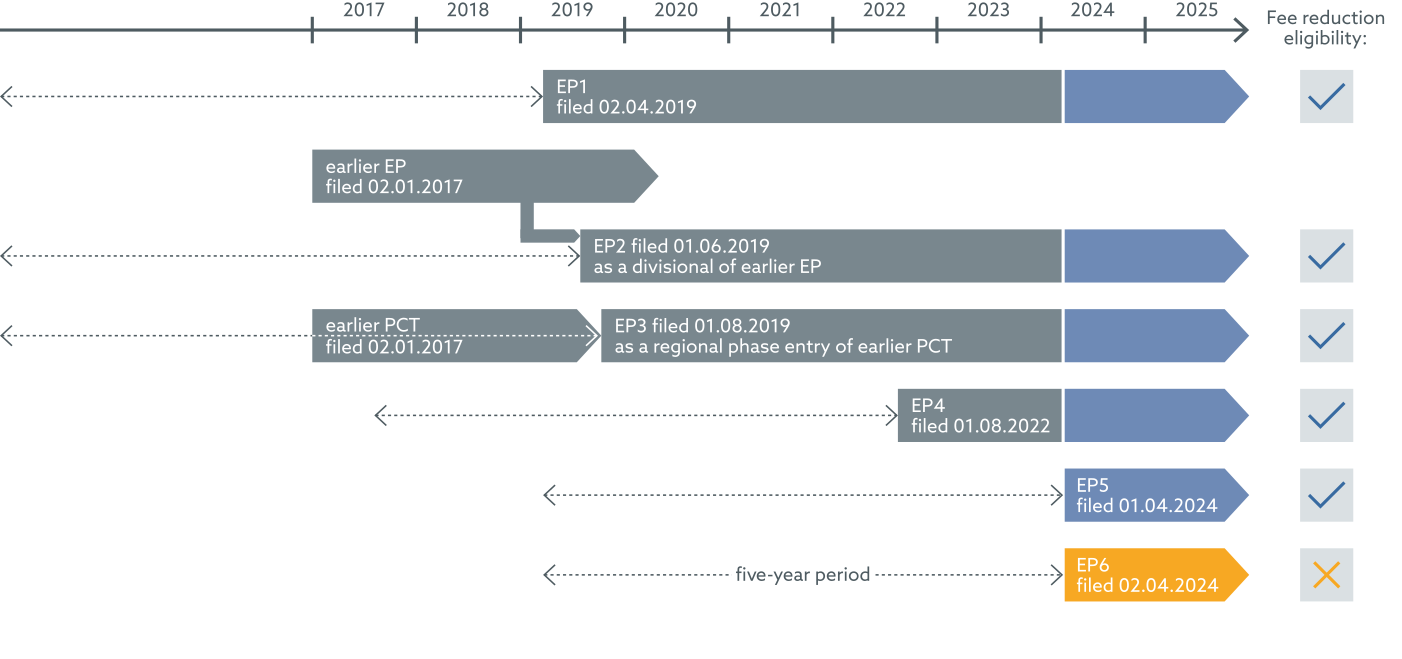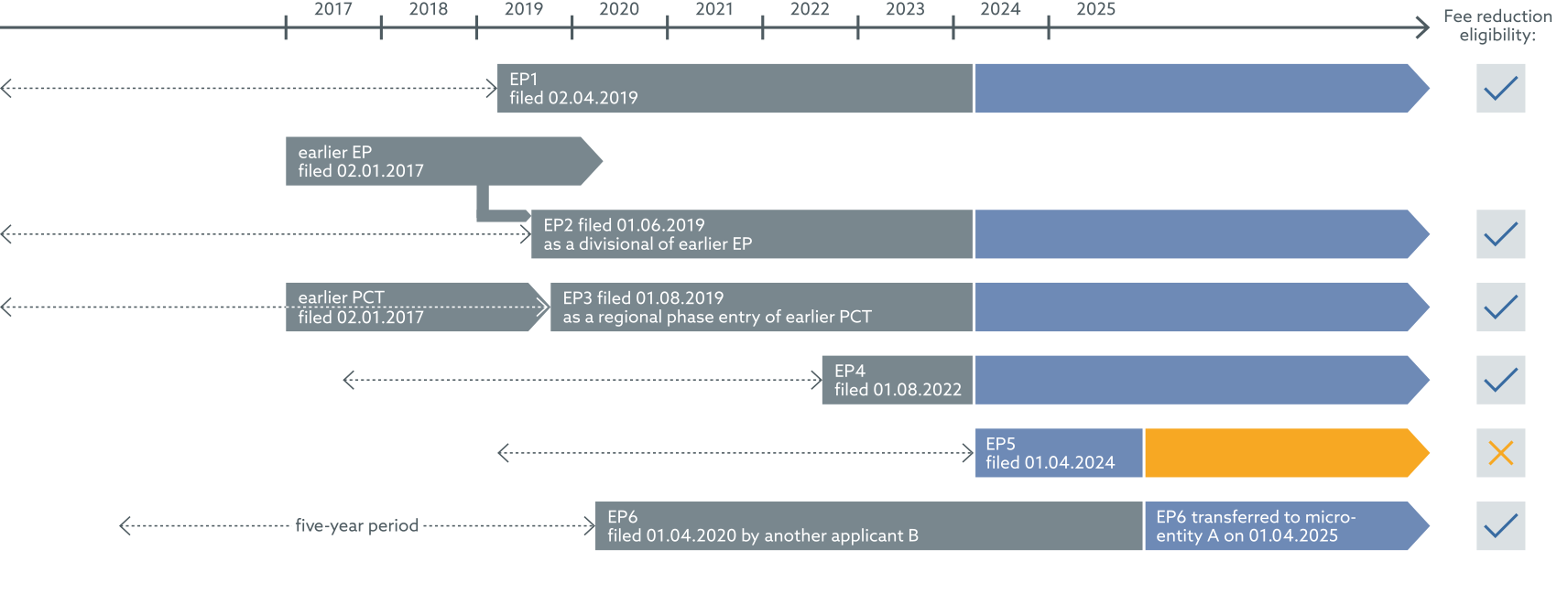New fee reductions at the EPO for microenterprises and other organisations
News | 28.03.2024
A new support scheme allowing for 30% reduction on most of the EPO official fees is available under new Rule 7a(3) EPC (in force from April 1, 2024).[1]
The new fee reductions apply to cases where:
- each applicant is a microenterprise, natural person, non-profit organisation, university or public research organisation; and
- the same person has not filed five or more EP applications or Euro-PCT applications within a period of five years preceding the date of filing of the EP application or the date of EP regional phase entry of the Euro-PCT application concerned.
The reductions apply irrespective of the language, nationality, residence, and principal place of business of the applicant (provided that all applicants are eligible types of entities).
Definitions of eligible types of entities
A “microenterprise”[2] is an enterprise which employs fewer than 10 persons, and whose annual turnover and/or annual balance sheet total does not exceed EUR 2 million.
"Non-profit organisations" are organisations which, by virtue of their legal form or statutes, are not permitted under the relevant law to be a source of income, profit or other financial gain for their owners, or, where they are permitted to make a profit, there is a legal or statutory obligation to reinvest the profits made in the interest of the organisation.
"Universities" are "classic" universities, i.e. higher education and research institutions as defined by the relevant legislation. However, comparable institutions, such as secondary or higher education establishments, are also considered to be universities.
"Public research organisations" are entities such as universities or research institutes that are organised under public law and which, irrespective of the way they are financed, have as their primary goal the conduct of fundamental research, industrial research or experimental development, and the dissemination of the results by way of teaching, publication or technology transfer. All profits must be reinvested in carrying out these activities, in the dissemination of the results or in teaching.
Less than five earlier EP applications within five years “cap”
The fee reductions apply to payments for European patent applications or Euro-PCT applications if the applicant has filed less than five applications with relevant dates of “filing” (as explained below) in the five years preceding the relevant date of the application for which the fee reduction is requested.
For any application with five or more previous applications falling within the five-year period, no fee reduction will be available. In other words, the reduction would apply for any specific application where less than five applications by the same applicant have been “filed” within five years before the relevant date of that specific application.
The relevant date of “filing” for the purposes of this new rule is the filing date (for direct EP applications), the date of receipt (for EP divisional applications), or the date of regional phase entry (for Euro-PCT applications). If multiple applications are filed by the same applicant with the same relevant date, the application numbers will determine the order for the purposes of the cap.
Here are some examples:
In the above scheme, an eligible entity A (a microenterprise) has filed various patent applications; the ones entitled to fee reductions are in blue. EP1 to EP4 are entitled to reduction of fees paid on or after April 1, 2024 (when the new system enters into effect). EP5 is entitled too: only EP1 to EP4 are counted for (and comply with) the “less than five earlier EP applications” cap, while the “earlier EP” is not relevant as it was filed before the five-year period relative to EP5. EP6 is not entitled: EP1 to EP5 are counted for and exceed the cap.
This scheme shows a similar scenario, but here EP6 is an application initially filed by another entity B, then transferred to microenterprise A. Upon registration of the transfer, EP6 is counted for assessing compliance with the “less than five earlier EP applications” cap; from this moment on, EP5 is not (but EP6 is) entitled to fee reductions.
For further examples, please refer to Annex 1 of the Notice from the EPO dated 25 January 2024 (OJ EPO 2024, A8).
Fees concerned and potential savings
|
EPO Fee |
Typical saving in EUR |
|
|
Filing fee, including any additional fees part of the filing fee |
40.5 |
|
|
Fee for a European search or the fee for a supplementary European search in the case of a Euro-PCT application searched by an International Searching Authority (ISA) other than the EPO |
456.00 |
|
|
Examination fee |
574.50 |
|
|
Retroactive reduction of the international search fee where the EPO acted as ISA (if the examination fee is paid on or after April 1, 2024) |
532.50 |
|
|
Designation fee |
205.50 |
|
|
Fee for grant |
324.00 |
|
|
Renewal fees for the European patent application |
Individual savings, e.g., |
Cumulative savings, e.g., |
|
for year 5: 300.00 |
for years 3–5: 760.50 |
|
|
for year 7: 393.00 |
for years 3–7: 1500.00 |
|
Risks and consequences of incorrect status or number of previous applications
If an applicant uses the new fee reduction scheme without being entitled to it (for whatever reason), any such fee will be treated by the EPO as not having been validly paid. Non-payment of one of the above-mentioned fees will lead to a loss of rights.
The applicant can then rely on the same legal remedies that would otherwise be available under the European Patent Convention if there is a failure to pay the respective fee for other reasons.
- In most instances, it will be possible to request further processing within two months from notification of an official communication informing on the loss of rights. Moreover, the EPO will monitor compliance with the cap of less than five earlier applications. If a reduced fee payment does not comply with this requirement, the applicant will normally be invited to pay the missing amount within a period of 2 months.
- If renewal fees are considered not to have been paid, the EPO allows for payment with surcharge within a 6-month period from the initial due date. This is potentially critical since the deadline for taking the legal remedy does not depend on the EPO or the applicant recognizing the ineffectiveness of the renewal fee payment. If lack of entitlement to a reduced renewal fee is noticed only after the above 6-month period has passed, the only remaining option for reviving the application would be to request re-establishment of rights. But this can only be successful if the “all due care requirement” is fulfilled. No legal remedy will be available if the ineffectiveness of the renewal fee payment is noticed more than one year after the initial due date.
In view of the above risk, it seems prudent to use the fee reduction for renewal fee payments only if it can be ensured that any change in the entitlement status is promptly communicated to the representative or service provider responsible for renewal fee payments.
Practical recommendations
An important take-home message is that the entitlement to this kind of fee reduction has an applicant-specific component and an application-specific component which must both be fulfilled. The applicant-specific component (whether the applicant qualifies as a microenterprise, natural person, non-profit organisation, university or public research organisation) may change over the course of time and must be continuously monitored. The application-specific component (the “less than five earlier EP applications” cap) is retained over the entire lifetime of an application,[3] but may change from one application to the next.
In practice, this means that an applicant of an eligible entity type wishing to use the fee reduction should perform the following steps:
- list all their EP applications, regardless of the status (pending, withdrawn, deemed withdrawn, refused or patent granted);
- assign the “relevant date of filing” to each EP application, i.e.: the filing date for direct EP applications, the date of receipt (for EP divisional applications), or the date of regional phase entry (for Euro-PCT applications);
- identify the application(s) for which less than five applications have been “filed” within five years before the relevant date of the application concerned; and
- declare status as entity entitled to a fee reduction under Rule 7a(3) EPC for these identified application(s) (e.g., by using EPO Form 1011) at the latest when the fee concerned is paid.
For renewal fee payments, special action seems advisable in view of the above-mentioned risk of an irreversible loss of rights: an internal check system should be installed, allowing to promptly inform the responsible representative once entitlement to the fee reduction is lost.
[1] For details, see the Notice from the EPO dated 25 January 2024 (OJ EPO 2024, A8) and the decision of the Administrative Council of the EPO of 14 December 2023 (CA/D 16/23, OJ EPO 2024, A3).
[2] Defined according to Art. 2 of the Annex to Commission Recommendation 2003/361/EC of 6 May 2003.
[3] An exception to this general rule applies if one or more EP applications “filed” earlier are transferred to the applicant, so that the application of interest no longer meets the five-application cap; fortunately, this has only effect for future payments, so past fee payments do not risk becoming retroactively invalid.
back



